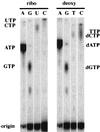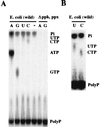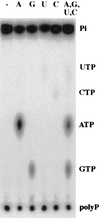Polyphosphate kinase as a nucleoside diphosphate kinase in Escherichia coli and Pseudomonas aeruginosa
- PMID: 9012801
- PMCID: PMC19530
- DOI: 10.1073/pnas.94.2.439
Polyphosphate kinase as a nucleoside diphosphate kinase in Escherichia coli and Pseudomonas aeruginosa
Abstract
Generation of a wide variety of nucleoside (and deoxynucleoside) triphosphates (NTPs) from their cognate nucleoside diphosphates (NDPs) is of critical importance in virtually every aspect of cellular life. Their function is fulfilled largely by the ubiquitous and potent nucleoside diphosphate kinase (NDK), most commonly using ATP as the donor. Considerable interest is attached to the consequence to a cell in which the NDK activity becomes deficient or over-abundant. We have discovered an additional and possibly auxiliary NDK-like activity in the capacity of polyphosphate kinase (PPK) to use inorganic polyphosphate as the donor in place of ATP, thereby converting GDP and other NDPs to NTPs. This reaction was observed with the PPK activity present in crude membrane fractions from Escherichia coli and Pseudomonas aeruginosa as well as with the purified PPK from E. coli; the activity was absent from the membrane fractions obtained from E. coli mutants lacking the ppk gene. The order of substrate specificity for PPK was: ADP > GDP > UDP, CDP; activity with ADP was 2-60 times greater than with GDP, depending on the reaction condition. Although the transfer of a phosphate from polyphosphate to GDP by PPK to produce GTP was the predominant reaction, the enzyme also transferred a pyrophosphate group to GDP to form the linear guanosine 5' tetraphosphate.
Figures





Similar articles
-
The multiple activities of polyphosphate kinase of Escherichia coli and their subunit structure determined by radiation target analysis.J Biol Chem. 2000 Feb 11;275(6):3977-83. doi: 10.1074/jbc.275.6.3977. J Biol Chem. 2000. PMID: 10660553
-
Use of Escherichia coli polyphosphate kinase for oligosaccharide synthesis.Biosci Biotechnol Biochem. 1998 Aug;62(8):1594-6. doi: 10.1271/bbb.62.1594. Biosci Biotechnol Biochem. 1998. PMID: 9757566
-
Amino acids involved in polyphosphate synthesis and its mobilization are distinct in polyphosphate kinase-1 from Mycobacterium tuberculosis.PLoS One. 2011;6(11):e27398. doi: 10.1371/journal.pone.0027398. Epub 2011 Nov 14. PLoS One. 2011. PMID: 22110640 Free PMC article.
-
Inorganic polyphosphate and polyphosphate kinase: their novel biological functions and applications.Biochemistry (Mosc). 2000 Mar;65(3):315-23. Biochemistry (Mosc). 2000. PMID: 10739474 Review.
-
Nucleoside diphosphate kinase: role in bacterial growth, virulence, cell signalling and polysaccharide synthesis.Mol Microbiol. 1998 Jun;28(5):875-82. doi: 10.1046/j.1365-2958.1998.00846.x. Mol Microbiol. 1998. PMID: 9663675 Review.
Cited by
-
Polyphosphate kinase (PPK2), a potent, polyphosphate-driven generator of GTP.Proc Natl Acad Sci U S A. 2002 Dec 24;99(26):16684-8. doi: 10.1073/pnas.262655299. Epub 2002 Dec 13. Proc Natl Acad Sci U S A. 2002. PMID: 12482933 Free PMC article.
-
SwoHp, a nucleoside diphosphate kinase, is essential in Aspergillus nidulans.Eukaryot Cell. 2003 Dec;2(6):1169-77. doi: 10.1128/EC.2.6.1169-1177.2003. Eukaryot Cell. 2003. PMID: 14665452 Free PMC article.
-
Roles of rel(Spn) in stringent response, global regulation and virulence of serotype 2 Streptococcus pneumoniae D39.Mol Microbiol. 2009 May;72(3):590-611. doi: 10.1111/j.1365-2958.2009.06669.x. Mol Microbiol. 2009. PMID: 19426208 Free PMC article.
-
The exceptional form and function of the giant bacterium Ca. Epulopiscium viviparus revolves around its sodium motive force.Proc Natl Acad Sci U S A. 2023 Dec 26;120(52):e2306160120. doi: 10.1073/pnas.2306160120. Epub 2023 Dec 18. Proc Natl Acad Sci U S A. 2023. PMID: 38109545 Free PMC article.
-
Use of an Escherichia coli recombinant producing thermostable polyphosphate kinase as an ATP regenerator to produce fructose 1,6-diphosphate.Appl Environ Microbiol. 2007 Sep;73(17):5676-8. doi: 10.1128/AEM.00278-07. Epub 2007 Jul 6. Appl Environ Microbiol. 2007. PMID: 17616610 Free PMC article.
References
-
- Biggs J, Hersperger E, Steeg P S, Liotta L A, Shearn A. Cell. 1990;63:933–940. - PubMed
-
- Munoz-Dorado J, Inouye M, Inouye S. J Biol Chem. 1990;265:2702–2706. - PubMed
-
- Wallet V, Mutzel R, Troll H, Barzu O, Wurster B, Veron M, Lacombe M L. J Natl Cancer Inst. 1990;82:1199–1202. - PubMed
-
- Okabe-Kado J, Kasukabe T, Hozumi M, Honma Y, Kimura N, Baba H, Urano T, Shiku H. FEBS Lett. 1995;363:311–315. - PubMed
Publication types
MeSH terms
Substances
LinkOut - more resources
Full Text Sources
Other Literature Sources
Molecular Biology Databases

